Versatile Vines
01 Apr 2021
Vines add beauty to any garden, but their value doesn’t end there
By Carol Brock
Vines are useful in so many ways. Some feed pollinators and shelter wildlife. Others offer lovely fragrance and heavenly flowers. Some sprout edible fruits, and all can beautify fences and patios while adding privacy. Versatile vines also shade us when grown above a pergola and look stunning draped over a trellis or arbor.
We asked local gardening experts to share their favorite vine picks for different purposes. Here’s what they said.
Brilliant Blooms
Clematis x Jackmanii is a sure bet for spectacular blooms, says Jim Klett, professor and extension landscape horticulturist at Colorado State University. The vine’s large, eye-catching purplish flowers are showy in any garden, but they don’t bloom all season long.

To counter that, combine early-blooming varieties with later-blooming ones, suggests Jesse Eastman, owner and general manager of Fort Collins Nursery. “This can give the effect of nearly all-season blooming,” he says. Combine an early-blooming variety like Nelly Moser (Clematis x ‘Nelly Moser’), whose pink flowers with dark-pink ribbons bloom late spring through summer, with a late bloomer like Sweet Summer Love (Clematis x ‘Sweet Summer Love’), whose fragrant purple, cranberry and violet flowers bloom July through September.
“Clematis love a sunny spot in the garden, but will benefit from light afternoon shade in areas that get really hot in the summer,” says Georgia Clay, new plants manager at Monrovia Nursery, a distributor to retail nurseries nationwide. “Mulching with a thick layer of organic material near the base, or even using the shade from nearby low-growing plants, will keep your clematis roots healthy and cool.”

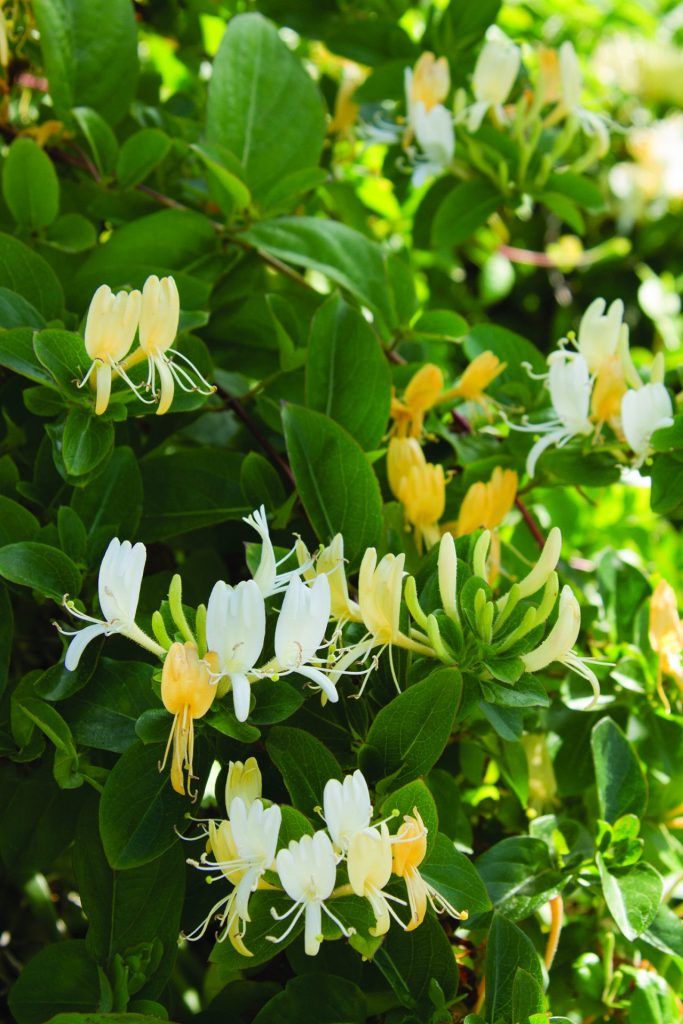
Pollinator Paradise
Honeysuckles are as their name implies: nectar-rich. Pollinators adore them, and they’re fragrant, too. While honeysuckles get a bad rap for being invasive in milder, wetter regions, Eastman says they don’t pose that problem in Colorado’s arid conditions; just don’t overwater them. He recommends Hall’s Honeysuckle (Lonicera japonica ‘Halliana’) or Major Wheeler Honeysuckle (Lonicera sempervirens ‘Major Wheeler’).
Bill Melvin, president and founder of Ecoscape Environmental Design in Boulder, agrees. “Hall’s Honey-suckle is great for ease of care, and hummingbirds, butterflies and bumblebees love the tubular blossoms.” Honeysuckles are extremely adaptable, too. “They’ll easily grow in most soil types and quickly fill in a fence or other landscape feature,” Clay says. “They prefer full sun and are beautiful when trained to grow upward on a trellis, allowed to trail over a retaining wall, or used as ground cover along a slope.”
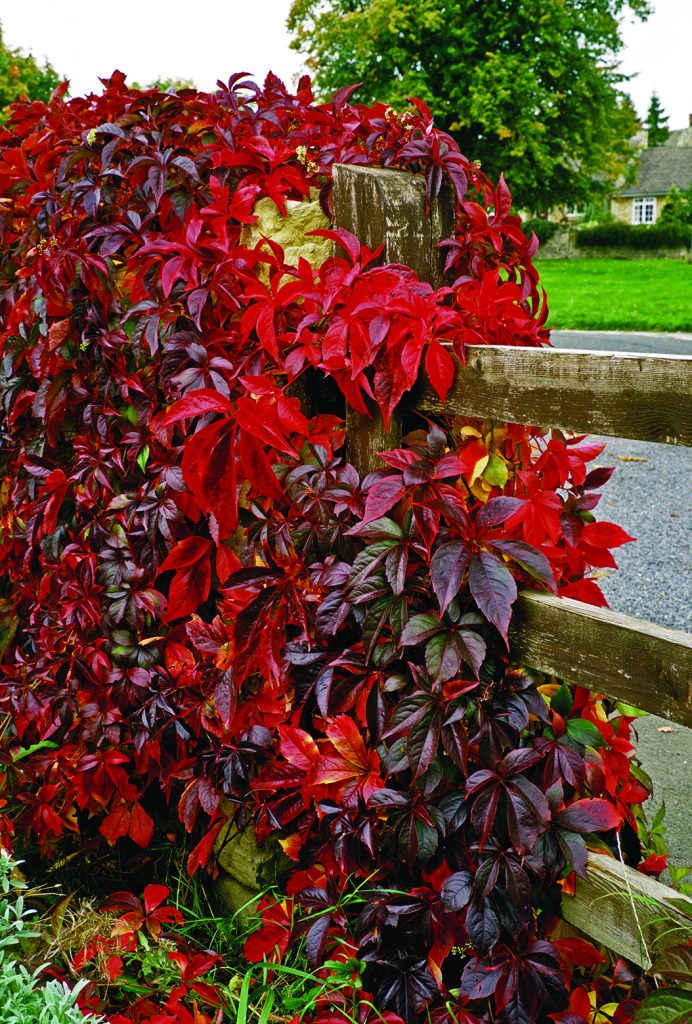
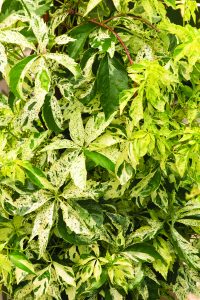
Simple Shelter
Virginia Creeper (Parthenocissus quinquefolia) is a native vine that provides shelter for many types of wildlife, berries for birds and fabulous fall color for humans. “It produces clusters of small purple berries that are an important food source for a wide variety of birds,” Eastman says. “It’s vigorous and can be pushy, but it’s not invasive by technical horticultural standards.” To keep it contained, only water it occasionally.
“Virginia Creeper is a fast grower that securely attaches itself to walls and other surfaces to form a thick cover,” Clay says. “Best planted in part sun, this is an easy-to-grow vine that’s tolerant of urban conditions and a wide range of soil types.” She likes the ‘Star Showers’ variety for its beautiful green-and-cream speckled leaves that take on a pink glow in cooler weather. “It looks gorgeous climbing up stone or masonry.”
Fetching Fragrance

shutterstock.com
If you’re looking for fragrance, wisteria is a wonderful option, says Eastman, noting the vine prefers shelter from intense sun and drying winds. “I particularly like the American variety, Amethyst Falls Wisteria, which is a little more well-behaved than many Asian varieties.” Perfect for smaller spaces, Amethyst Falls Wisteria grows at about a third of the rate of Asian wisterias, with fragrant purple flowers that bloom at an early age and weep gracefully downward. “It needs full to partial sun and regular watering,” Clay notes.
Edible Embellishments

Don’t overlook edible vines, as both grapes and hops grow very well on the Front Range. Bees love grapevine flowers, while people and wildlife love the luscious grapes. Colorado’s native grape, Vitis riparia, is invasive, so Melvin suggests sticking with Concord, Swenson red or white, Niagara, Edelweiss or Fredonia grapes. He also recommends Saint Theresa Seedless Grape, “which is sweet, hardy and disease-resistant.”
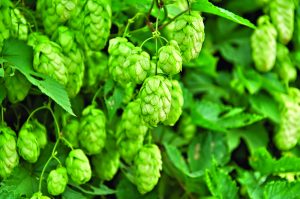
“Hops are wonderfully fast-growing vines that die to the ground every year,” Eastman says, “and are, of course, an essential ingredient for home brewers.” Melvin casts another vote for the beer staple: “Hops offers a lot of shelter for insects and caterpillars, and the medicinal strobiles are a great sleep aid,” he says. Just crush them between your fingers and add to your beverage of choice.
Humulus lupulus is a common hops variety that grows well here but, Melvin cautions, “It’s aggressive.” It’s important to plant aggressive plants in the right place, he says. “In our climate, many aggressive growers are limited in their ability to spread by how much water they receive, so make this controllable.” For example, don’t plant aggressive growers near regularly irrigated areas like turf. “Drip irrigation is much easier to manage and can determine where plants will be able to run or be contained.”
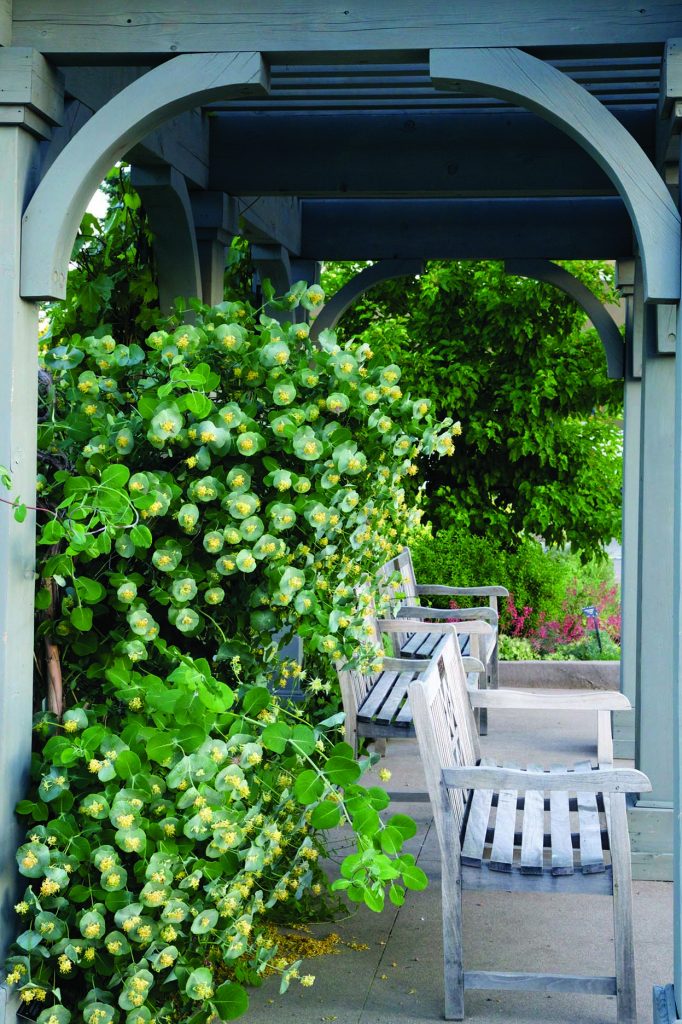
Beautiful Bracts
If flashy foliage is your thing, Kintzley’s Ghost Honey-suckle—a Plant Select pick for this region—is a must-have. “Its silvery foliage produces a fascinating display of silver bracts that last all season,” Eastman says. Deer resistant and attractive to pollinators, Kintz-ley’s Ghost (Lonicera reticulata) likes full sun, little water and is covered in yellow flowers in spring. But the plant’s unusual circular bracts—the size and color of silver dollars—are simply hard to beat, says Eastman.












